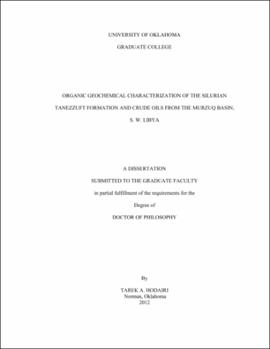| dc.contributor.advisor | Philp, R. Paul | |
| dc.creator | Hodairi, Tarek A. | |
| dc.date.accessioned | 2019-05-01T17:24:58Z | |
| dc.date.available | 2019-05-01T17:24:58Z | |
| dc.date.issued | 2012 | |
| dc.identifier | 99136195102042 | |
| dc.identifier.uri | https://hdl.handle.net/11244/319482 | |
| dc.description.abstract | Source rock and crude oil samples collected from the Murzuq Basin, S.W. Libya have been investigated by a variety of organic geochemical methods, including Rock-Eval pyrolysis (RE), gas chromatography (GC), gas chromatography mass spectrometry (GCMS), and graptolite reflectance. Rock samples were collected from the Tanezzuft Formation (`cool' shales) from several wells of A-Field located in Block NC-115. Furthermore, crude oil samples were collected from A-, R-, and I-Fields in NC-115 and NC-186 Blocks. The distributions of n-alkanes, isoprenoids, terpanes, and steranes (saturate fractions) along with phenanthrenes, mono- and triaromatic steroid hydrocarbons (aromatic fractions) were studied and used to determine organic matter composition, nature of depositional environments and levels of thermal maturity for both rock and crude oil samples. | |
| dc.description.abstract | The results from the study of the rock samples show a close correlation between RE data and the biomarker parameters. Based on RE data, organic matter is characterized as being poor to fair in TOC. This is most probably due to the relative oxicity of the depositional environment. The samples are shown to be mainly Type III kerogen (gas prone) with some contribution of mixed type II and III kerogens (gas/oil prone). The predominance of nC17 over nC25 in n-alkane profiles suggests a high input of marine-derived organic matter. However, values of Pr/nC17 vs. Ph/nC18 and the stable carbon isotopic composition for saturate and aromatic hydrocarbons of selected extracts along with the predominance of C27 and C29 steranes in most of the samples indicate that organic matter in these sediments has mixed marine/terrigenous sources with a slight influence of marine input as suggested by the presence of C30 steranes and a predominance of tricyclic terpanes in most samples. The values of Pr/Ph ratios (0.83-2.32) suggest that these sediments were deposited under sub-oxic conditions, which is also indicated by the presence of C30-diahopane in most of the samples, low ratios of C35 to C34 homohopanes, high diasterane/sterane ratios as well as low quality organic matter manifested by low hydrogen indices. Thermal maturity parameters, including the sterane isomerization ratios C29áââ/(áââ+ááá), C29ááá20S/(20S+20R), homohopane isomerization ratios C3222S/(22S+22R), Ts/(Ts+Tm) ratios, and C30-moretanes/C30-hopanes (C30âá/C30áâ) ratios, together with organic petrography and Rock-Eval data (e.g. Tmax and HI vs. Tmax crossplot), support early to intermediate maturity levels for the rock samples. However, it is proposed that the Uppermost Silurian Tanezzuft Formation (`cool' shale) has not generated, or will not generate, considerable amounts of hydrocarbons in the Murzuq Basin. | |
| dc.description.abstract | Based on biomarker distributions (e.g. n-alkanes, isoprenoids, terpanes, and steranes), the source of crude oils is characterized by mixed marine/terrigenous organic matter indicated by the stable carbon isotopic composition for saturate and aromatic hydrocarbons of selected crude oils. The values of the Pr/Ph (1.36-2.1), C30-diahopane/C29Ts, and diasterane/sterane ratios together with the low values of C29/C30-hopane ratio and the crossplot of the dibenzothiophene/phenanthrene ratio (DBT/P) vs. Pr/Ph ratio in most of oil samples suggest that the oils were sourced from marine clay-rich sediments deposited in sub-oxic (mild anoxic) depositional environments. Assessment of thermal maturity based on phenanthrenes, aromatic steroids (e.g. monoaromatic (MA) and triaromatic (TA) steroid hydrocarbons), terpanes (e.g. tricyclic/hopane ratios), diasterane/sterane ratios, as well as the high concentrations of pregnane and homopregnane, indicates that crude oils from A-Field are at high levels of thermal maturity, while oils from R- and I-Fields are characterized by intermediate levels of thermal maturity. Based on the distributions of n-alkanes (n-C11 - n-C32) along with the absence of 25-norhopanes in all of the crude oils, the oils do not appear to have been biodegraded. Correlation of crude oils permits the establishment of one genetic family and is supported by the stable carbon isotope values. These oils can be divided into two subfamilies based on the differences in maturities as shown in the Pr/nC17 vs. Ph/nC18 crossplot. Subfamily-A is represented by all oils from A-Field-NC115, which is characterized by high levels of maturity. Subfamily-B is described by oils from R- and I-Fields that are at intermediate levels of maturity. The two subfamilies may represent two different phases of hydrocarbon generation that took place in the Murzuq Basin. In summary, the geochemical characteristics of the oil samples from A-, R-, and I-Fields from the Murzuq Basin suggested that all the crude oils were generated from similar source rocks. Depositional environment conditions and advanced thermal maturities of these oils are also consistent with the previously published geochemical interpretations of the Rhuddanian `hot' shale Tanezzuft Formation, which is thought to be the main source rock in the Murzuq Basin. | |
| dc.description.abstract | Based on the relative concentration of biomarkers, oil/source rock correlation suggests that the Tanezzuft `cool' shales in this study show a lack of correlation with crude oils. | |
| dc.format.extent | 257 pages | |
| dc.format.medium | application.pdf | |
| dc.language | en_US | |
| dc.relation.requires | Adobe Acrobat Reader | |
| dc.subject | Petroleum--Geology--Murzuq Basin (Libya and Niger) | |
| dc.subject | Geochemistry--Murzuq Basin (Libya and Niger) | |
| dc.title | ORGANIC GEOCHEMICAL CHARACTERIZATION OF THE SILURIAN TANEZZUFT FORMATION AND CRUDE OILS FROM THE MURZUQ BASIN, | |
| dc.type | text | |
| dc.type | document | |
| dc.thesis.degree | Ph.D. | |
| ou.group | Mewbourne College of Earth and Energy::ConocoPhillips School of Geology and Geophysics | |
